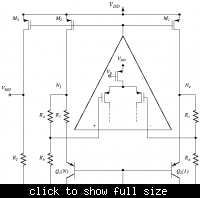holddreams
Full Member level 6
The attachment is the circuit of razavi's book ,figure 11.9.
My questions are:
1.How can I simulate the stability of this bandgap circuit?
2.Can we exchange the OPAMP input ?That is ,let the negative input connect with the A ,and the positive input connect with nA?
Thanks.
My questions are:
1.How can I simulate the stability of this bandgap circuit?
2.Can we exchange the OPAMP input ?That is ,let the negative input connect with the A ,and the positive input connect with nA?
Thanks.
